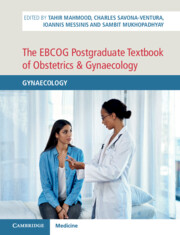Book contents
- The EBCOG Postgraduate Textbook of Obstetrics & Gynaecology
- The EBCOG Postgraduate Textbook of Obstetrics & Gynaecology
- Copyright page
- Dedication
- Contents
- Videos
- Contributors
- Preface
- Section 1 Basic Sciences in Gynaecology
- Section 2 Menstrual Disorders
- Section 3 Reproductive Endocrinology and Infertility
- Section 4 Contraception and STIs
- Section 5 Post-Reproductive Care
- Section 6 Vulva and Vagina
- Section 7 Cervix
- Section 8 Uterus
- Section 9 Ovary and Fallopian Tubes
- Section 10 Operative Gynaecology
- Chapter 43 Basic Hysteroscopy
- Chapter 44 Advanced Hysteroscopy
- Chapter 45 Basic Laparoscopic Gynaecological Procedures
- Chapter 46 Advanced Laparoscopic Gynaecological Procedures
- Chapter 47 Robotic Gynaecological Surgery
- Chapter 48 Myomectomy
- Chapter 49 Hysterectomy for Benign Conditions
- Chapter 50 Reversal of Sterilization in Females and Males to Restore Fertility
- Section 11 Public Health Issues in Gynaecology
- Section 12 Miscellaneous
- Index
- Plate Section (PDF Only)
- References
Chapter 50 - Reversal of Sterilization in Females and Males to Restore Fertility
from Section 10 - Operative Gynaecology
Published online by Cambridge University Press: 24 November 2021
- The EBCOG Postgraduate Textbook of Obstetrics & Gynaecology
- The EBCOG Postgraduate Textbook of Obstetrics & Gynaecology
- Copyright page
- Dedication
- Contents
- Videos
- Contributors
- Preface
- Section 1 Basic Sciences in Gynaecology
- Section 2 Menstrual Disorders
- Section 3 Reproductive Endocrinology and Infertility
- Section 4 Contraception and STIs
- Section 5 Post-Reproductive Care
- Section 6 Vulva and Vagina
- Section 7 Cervix
- Section 8 Uterus
- Section 9 Ovary and Fallopian Tubes
- Section 10 Operative Gynaecology
- Chapter 43 Basic Hysteroscopy
- Chapter 44 Advanced Hysteroscopy
- Chapter 45 Basic Laparoscopic Gynaecological Procedures
- Chapter 46 Advanced Laparoscopic Gynaecological Procedures
- Chapter 47 Robotic Gynaecological Surgery
- Chapter 48 Myomectomy
- Chapter 49 Hysterectomy for Benign Conditions
- Chapter 50 Reversal of Sterilization in Females and Males to Restore Fertility
- Section 11 Public Health Issues in Gynaecology
- Section 12 Miscellaneous
- Index
- Plate Section (PDF Only)
- References
Summary
When the desire to have a child no longer exists and the family is completed, women and men can opt for tubal sterilization or vasectomy as a definitive form of contraception. For the female partner it offers the opportunity that she can rely on a natural hormonal cycle without the need to use a hormonal or mechanical contraceptive method. Most frequently, due to changes in family situation, couples can regret the sterilization procedure and opt for another pregnancy. Because of proven fertility, pregnancy rates after microsurgical tubal anastomosis vary between 60% and 80%. Outcomes of vasovasostomy are quite variable, with patency rates ranging from 69.2% to 97.8% and pregnancy rates ranging from 36.8% to 92.5%. These results have to be balanced against the possibilities of artificial reproductive techniques. Factors influencing this decision are age, method of tubal sterilization, desire to have only one additional child and reimbursement in health insurance cases.
- Type
- Chapter
- Information
- The EBCOG Postgraduate Textbook of Obstetrics & GynaecologyGynaecology, pp. 437 - 442Publisher: Cambridge University PressPrint publication year: 2021

